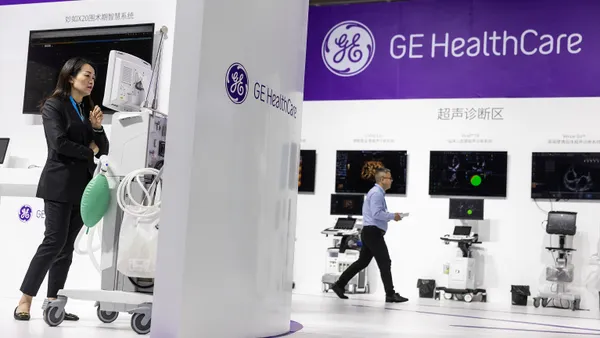Dive Brief:
- GE published a regulatory filing about the spinoff of its healthcare unit, which it expects to complete in the first week of 2023, if the transaction is approved by its board of directors. GE HealthCare will be listed on the Nasdaq under the ticker “GEHC.”
- The filing provides a detailed look at the opportunities and risks facing GE HealthCare, from the likelihood of Chinese competitors winning market share to increases in the number and sophistication of data security threats.
- The spinoff company will include GE’s imaging, ultrasound, patient care solutions and pharmaceutical diagnostics businesses. Last year, GE’s healthcare segment reported $17.59 billion in revenue, a 2% increase from 2020.
Dive Insight:
As part of the GE conglomerate, the healthcare unit has only disclosed a limited look at its opportunities and risks in previous financial regulatory filings. Now that GE HealthCare is preparing to go solo, the company shared a more detailed analysis of the forces that will shape the business over the coming years.
GE HealthCare’s pitch to investors rests on its position in an $84 billion global industry that it expects to grow 4% to 6% a year through 2025. The company is looking to macro trends such as growing adoption of precision health, the digitization of healthcare, and improving access to care in emerging markets to drive growth.
The filing also discusses the risks that could disrupt the business. GE HealthCare cites the implementation of localization requirements as a threat, explaining that it expects “Chinese competitors to continue to gain market share supported by Chinese government policies favorable to locally-based manufacturers.”
Management also identified third-party entities that specialize in the repair and maintenance of medical devices as a threat to its service organization. The competitors “could adversely impact our business and results of operations by driving down quality and price levels for services and repairs,” according to GE.
Other threats discussed in the filing include supply chain pressures and cybersecurity. GE HealthCare expects supply chain pressures to continue to hurt its businesses “for some period of time.” While the company has worked to diversify its suppliers, “in many instances there may be a single source or sole supplier with no alternatives yet identified,” exposing it to risks of shortages and price fluctuations.
On the cybersecurity front, GE HealthCare said its “IT systems have been subject to computer viruses, malicious code, unauthorized access, and other cyber-attacks.” The threats have become more frequent and sophisticated, GE HealthCare said, and the company may “be exposed to a more significant risk if such actions are taken by state or state-affiliated actors.”











